In the Northwest Caribbean and South Florida, late December to mid-March, is “Norther” season. Cold fronts, sometimes as often as one a week, blow through disrupting the tranquility of paradise. 2010 was an unusual year with more like 2-3 northers a week – sometimes there would only be a day between the fronts. Here are some tips that have served us well for anchoring for a norther.
1. Know the Weather! Cold fronts or northers are generally predicted well in advance. These are fronts moving through packing wind – sometimes up to 20-30 knots and they’re well predicted so savvy cruisers choose their anchoring locations for all around wind protection. Before a norther or cold front the wind will generally be from the south, then switch with a BAM to the northwest, then northeast, then back to the easterly trades. We have multiple sources for weather aboard – from the NW Caribbean Net to Chris Parker’s daily e-mail forecast and also the NOAA daily NW Caribbean text forecast. The timing for the norther may vary between the three, but the prediction is usually accurate.
2. Pick a Protected Anchorage — at a minimum you will need protection from the northwest to northeast from wind and waves. It’s best to be anchored in an anchorage with all around protection since prior to the norther the wind will likely come from a southerly component.
The first time we weathered a norther at anchor, we were in Belize. Looking for a protected anchorage, we chose the Drowned Cayes, a maze of mangroves close to Belize City. Being totally naive to cruising, we figured there would be at least hundreds of boats converging on what looked to us like the best storm anchorage in the area so we arrived literally a WEEK ahead of time to get our spot and get set. The fallacy to arriving to early for a norther is that often before a storm, the wind totally DIES … no wind, nada. And the noseeums take advantage of the opportunity to swarm your home! The morning before the norther, we were awakened from sleep with an epic attack – literally we were both hiding beneath our sheets, captive to the swarms of supposedly noseeums – i.e. you’re not supposed to be able to SEE them, but because they were so thick, we could see black layers through our sheets! We almost smothered before the time advanced to far enough past sunrise that they retreated somewhat so we could escape! Noseeums are the worst at sunset and sunrise, just like mosquitoes. BTW, we shared the anchorage with just one other boat that time and the boats were separated by mangroves so there was no one around that we could even see!
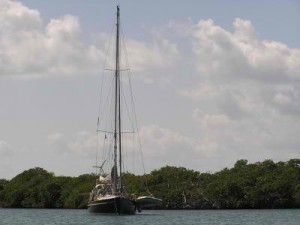
Mangrove anchorages often work well to weather northers. The water is deep right up to the edge of the mangroves (although be aware that the noseeums lie in wait, the closer you are, the quicker they converge on your boat!) so you have no problem with fetch during the worst of the norther. The bottom is often sticky mud so your anchor disappears and you’ll have trouble getting it up! Be sure to back down hard on the anchor though because some mangrove anchorages can be so muddy that the anchor literally just drags through the mud, not setting well at all.
3. Make sure your primary anchor is well set. We drop it and let the wind carry the boat back to begin to set it. We try to wait a few minutes before backing down HARD — full throttle for several seconds while David stands at the bow with his foot on the chain – if it’s moving the chain will vibrate and you can tell. We used to just back down mid-throttle until an old cruising salt friend said “Would you rather know NOW if it’s not going to hold, or in the middle of a storm?” On the other hand, if it’s not set quite right, you’ll get frustrated by continually pulling it out. If you never dive on your anchor any other time, this is the time to dive it! Hand set it if necessary. Wriggle it into that bottom. If the bottom isn’t conducive to hand burying it, push the tip in and then back down again. Make sure that anchor is well buried and not just laying on it’s side!
4. Use PLENTY of scope on your anchor rode. This is the biggest problem cruisers seem to have. Correct anchor scope varies depending on the depth of the water and your chosen rode. We have an all chain rode and we like to use 5 to 1 when we’re anchoring normally, up to 10 to 1 when we’re anchoring for a storm or if the anchorage is less than optimal. Don’t forget to include the several feet from the waterline to the bow in your calculations. For example, if we’re in 10 feet of water, it’s another 4 feet to our bow, so we do the calculation on 14 feet, not 10. So 10 to 1 would be 140 feet, not 100. 100 in that instance would be 7 to 1 scope, not 10 to 1. Obviously use your judgement, unlike the boat in Isla that had literally several hundred feet of anchor rode out in 15′ of water – crowded anchorages present different problems and you can’t use that much scope or you’ll be swinging into everyone else! Just for fun one norther, David got in the water when it was blowing over 30 (YIKES!) and watched the chain and anchor behavior. He was happy to report that despite the bucking that it seemed the boat was doing, the anchor rode was not lifting off the bottom anywhere close to the anchor itself. In other words, even though it felt aboard like we were taking a beating, we were secure and not going anywhere!
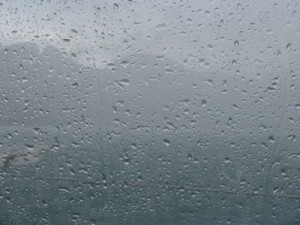
5. Consider setting a 2nd anchor. Since we don’t have the luxury of a double anchor roller on our bow, we take the anchor out and hand set it in the dinghy – we use an oversize Fortress because it’s light and although bulky, easier to handle. We set one anchor to the NW and the other to the NE, the two directions we anticipate the wind will blow. Keep in mind, the wind is often stronger after the norther passes and the wind switches to the NE – especially if there’s a strong high filling in behind the cold front/norther.
6. Reduce windage aboard the boat – we drop our kayaks to the deck instead of leaving them up on the lifelines.
7. Generally we remove the engine from the dinghy and put it back on the rail. If it’s forecast to be a bad storm, we’ll drop the dinghy into the water and trail it off the stern directly behind the boat, usually close. We always keep it chained to the boat even though the likelihood of thieves being out in a storm and wanting to steal an inflatable without an engine are small. If you trail the dinghy in the water, be aware that in torrential rains, you may need to get in it and bail! We have known of dinghies swamped by too much water during a storm.
8. Lengthen the nylon snubber on a chain rode to absorb the shock better and not pull on the anchor if the waves get to be a bit raucous – which, if we’ve done well in selecting our anchorage, there shouldn’t be enough fetch to cause the boat to buck up and down too violently, but depending on the anchorage, some can be rougher than others.
9. Before the storm, we take bearings with our compass from three directions, hopefully with landmarks which will be visible in the dark of night during the storm. We turned on our GPS and wrote down the position so we know if we’re moving. Sometimes we set the anchor alarm, but our anchor alarm is too sensitive and we haven’t figured out how to make it not alert us through the sometimes wild figure 8’s a norther can cause.
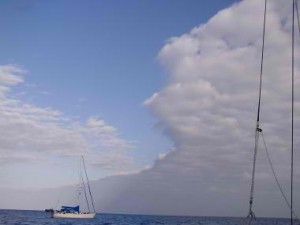
10. We’re always aboard the boat during a norther — I am constantly amazed when people leave their boats if a norther hits during the day… especially in anchorages known to be marginal holding such as Isla Mujeres … in addition to marginal holding Isla is open to the Northeast, bringing bigger waves than optimal during a norther. Every year, Isla becomes the “drag race” capital of the NW Caribbean. And every year boats drag and go aground with no one aboard in Isla. I guess I’m paranoid, I cannot understand why you would leave your boat, your home with a norther coming in an anchorage especially like Isla!
11. If the storm is wicked, we usually have an anchor watch – someone stays up to watch and make sure we aren’t moving.
Here’s part of an update I wrote when we endured a week long superstrong high in Port Royal, Roatan:
“Winterlude is securely anchored in Port Royal, Roatan where we’re listening to the wind whistle through the rigging & hoping the boat stays right where it is! To complement our series of firsts, this is the first time we’ve been at anchor during extended gale force winds. The noise is unbelievable when the wind tops 30 knots consistently – which it has for the past 5 days. Last night was our 5th night with no sleep. Consistently running 35-40 the noise sounds like a helicopter taking off every minute! Plus being constantly vigilant about whether the anchor is holding is just mentally exhausting. The really strange thing is that other than the wind howling & the waves cresting & water blowing everwhere, it’s been GORGEOUS weather! A full moon, bright bright stars, full sun, I swear the water is even prettier colors than normal, but it’s beginning to feel like being under seige, we can’t leave the boat, can’t get supplies & we’re running low on a couple of key items… toilet paper comes to mind, with rum a close second! And we’re getting a bad case of cabin fever after being confined to the boat for a week, we’ve almost read every book, done every Sukodu puzzle, studied too much Spanish & listened to too much “cruiser radio” – normal chatter on the VHF picks up when cruisers are confined to boats for extended periods!”
Our experience in northers is only in the NW Caribbean, SW Caribbean (where they generally don’t get) and Florida. If you have tips from other cruising locales, please post a comment and let us know before we head there! 🙂 THX! Jan
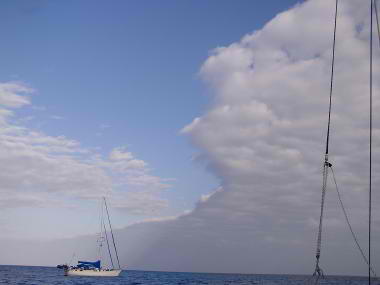


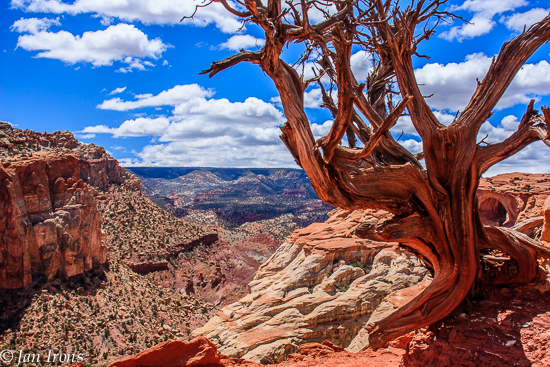







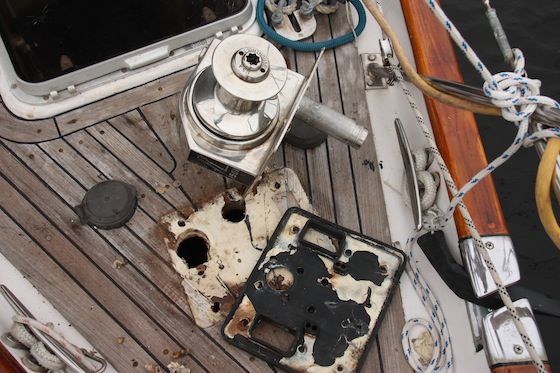
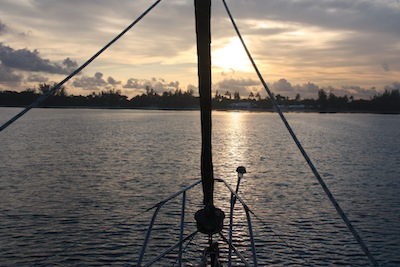
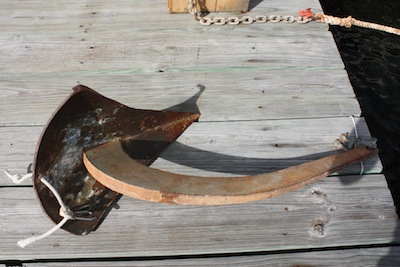
This is all good info, but 11 steps seems too much for many cruisers to seem to remember. I would reduce it to 3:
1) Pick a location with some protection from the fetch to windward and a bottom your anchor can set into, but not too silty.
2) Put out all the chain/rode you have on your primary anchor. Why are you worrying about 7 to 1 or 10 to 1? If its really going to blow put it all out! I like 20 to 1 or even 30-1. (And, if the anchorage is too crowded for 20 to 1 scope, find another anchorage!)
3) After letting the anchor settle in for awhile (maybe an hour?), back down on it at full power! Dont screw around with half power. If you dont move, then the anchor is going to hold you up through 35kts and probably more.
I always shake my head at folks who brag about having 10-1 chain out in the Bahamas where there is room to put out more. Especially bad are those still sitting on 5-1. I like to put out all 200ft I have and anchor in 6-8ft of water. It is very rare for the wind to pull 200ft of chain taught, the boat normally hangs on the chain not the anchor in up to 25kts. I have never dragged (knock on wood) with a Bruce 44 on a 25Klb boat, once I knew the anchor was properly set, and never have trouble sleeping as a result. Note, that I have had bottom conditions where the anchor would not hold at full reverse, normally where there is fine silt/mud or oyster shells. For those situations I either check the wind conditions and stay put if wind is light, or move to a different spot if strong winds are coming. Of note, I find the H and S entries on charts mean exactly what they say.
Thx Mark! Good distillation! Cheers! Jan